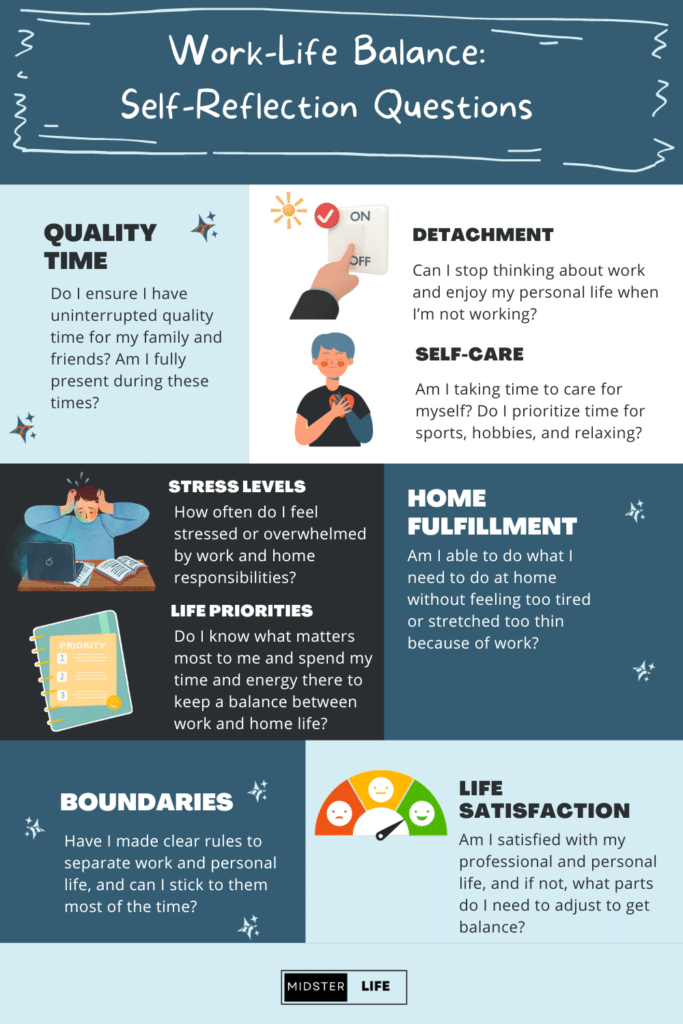Is Work-Life Balance Just A Dream For The Over 40s?
There’s a tightness in your gut and tension in your shoulders. Then, you catch a glimpse of your reflection in the mirror. Those bags under your eyes say it all.
With a big deadline looming, the pressure is on. Despite trying to zone in on your work, the escalating disagreement between your kids reverberates in the background— “NO FAIR!”, “It’s MY TURN!”. Your partner steps in, but stress is evident in their tone.
It’s the weekend. There’s swimming, a soccer game, and a kid’s party. But you must work. Then, your phone lights up; it’s the care home for your mom— “Damn,” you meant to call them yesterday.
An email from HR arrives in your inbox, “Finding Harmony: Work-life Balance Workshop – This Tuesday.” You can’t help but laugh. “Ha Work-life balance, that’s just a dream!”
Does this situation feel like something you’ve experienced? Especially when you’re over 40, it can seem like your job and family constantly fight for your attention and energy. Subsequently, it might feel like finding balance is just a dream, but it doesn’t have to be so hard to achieve.
Nevertheless, finding work-life balance post-40 is not only workable but crucial. In this post, we’ll explore some practical strategies to help pave your way to a more serene and rewarding life.
The Benefits of Work-Life Balance
Firstly, it’s important to start by recognizing there are a number of benefits of better work-life balance to both employer and employee:
- People have more time to run personal errands and address personal issues. As a result, they are less likely to use work time to do these activities or take sick days.
- People who have a better work-life balance are generally happier at work and less likely to quit. And this higher motivation can result in increased productivity.
- Improved well-being due to higher job satisfaction can also reduce stress-related illnesses.
The Reality of Work-Life Balance in Your 40s

So, although the benefits of balancing our jobs and personal lives are clear, it can be challenging to achieve. The reality is, once you’re over 40, your job probably demands more from you than it used to. You are more experienced now. But this comes with an expectation for you to handle more stress and make important decisions.
Additionally, we all face increased pressure to be better parents, partners, and friends. It’s entirely possible that you feel like you need to put everything and everyone else before yourself. This can lead to stress, burnout, and potential health issues if not addressed head-on.
However, it’s OK to hold your hands up and admit that life is off balance and things aren’t working.
But how do you recognize this in amongst the whirlwind of daily life?
Assessing Your Work-Life Balance After 40: 8 Reflective Questions

The first step is to take time to think about your life and assess if it is balanced.
Often, we know when parts of our lives aren’t working well. But by asking yourself some questions, you can pinpoint specifically what you need to change:
- Do I ensure I have uninterrupted quality time for my family and friends? Am I fully present during these times?
- Can I stop thinking about work and enjoy my personal life when I’m not working?
- How often do I feel stressed or overwhelmed by work and home responsibilities?
- Am I taking time to care for myself? Do I prioritize time for sports, hobbies, and relaxing?
- Am I able to do what I need to do at home without feeling too tired or stretched too thin because of work?
- Do I know what matters most to me and spend my time and energy there to keep a balance between work and home life?
- Have I made clear rules to separate work and personal life, and can I stick to them most of the time?
- Am I satisfied with my professional and personal life, and if not, what parts do I need to adjust to get balance?
If the answers to these questions indicate that you lack a balance between work and home, don’t worry.
Recognizing there’s an issue is just the first step. You can now take action! This is the best part.
8 Strategies to Achieve Work-Life Balance Post 40

Importantly, by deciding to balance your work and home life better, you are starting to look after your well-being. Furthermore, you are also showing commitment to your family and coworkers.
So, with your new-found commitment to restoring work-life balance, here are eight simple strategies to help you keep things in balance and feel more at peace in all parts of your life:
1. Set Boundaries and Decide What’s Important

Make clear rules to protect your personal time from work tasks. Learn to say “no” to things that are not essential. Focus on what’s most important to ensure you have enough time for work and personal activities.
Practical Examples:
Actionable Tips:
2. Use Flexibility and Work from Home

Working from home can offer a lot of flexibility. Use this to spend quality time with your family and deal with personal matters. Talk openly with your boss about your needs to ensure your work and personal life coexist peacefully.
Practical Examples:
Actionable Tips:
3. Focus on Wellness and Self-Care

Taking care of your body and mind is crucial. Find time for regular exercise, relaxation, and sleep. Include activities that refresh you and make you feel good. Take breaks, practice mindfulness, and enjoy hobbies.
Practical Examples:
Actionable Tips:
4. Manage Your Time Wisely

Use your time efficiently. Assign specific times to tasks and try to avoid doing many things at once. Use productivity strategies and apps to help you stay organized and blend your work and personal life more smoothly. By being more efficient, you can ensure work doesn’t eat into personal time. By being clear on your priorities and goals, you will free up mental space to focus on those you love.
Practical Examples:
Actionable Tips:
5. Seek Support and Guidance

You don’t have to do it alone. Connect with friends, family, coworkers, or support groups to share experiences and gain insights. Learning from people who have been through the same things can provide helpful advice and encouragement.
Practical Examples:
Actionable Tips:
6. Regularly Reflect and Adjust

Keep thinking about your work-life balance and adjust it to fit your changing needs and goals. Set realistic goals and tweak them as needed to maintain a balance that lets you grow and feel fulfilled professionally and personally.
Practical Examples:
Actionable Tips:
7. Use Paid Time Off

Ensure you prioritize time off. It’s easy to think we can’t take time off when we feel overwhelmed. But using your vacation or personal days to rest and deal with personal matters is critical. It provides a break from work and allows you time to refresh and readjust.
Practical Examples:
Actionable Tips:
8. Invest in Learning New Things

Keep learning and picking up new skills or hobbies. Attend workshops or events focusing on managing stress and balancing different parts of your life. This helps you feel more accomplished and grows you as a person.
Using these strategies, you can create a more peaceful and balanced life, managing work tasks and personal happiness.
Practical Examples:
Actionable Tips:
Attaining a work-life balance, especially post-40, is not a dream but a practical reality you can achieve with dedication and thoughtful strategies.
Setting clear rules for work and personal time is the starting point. But by maintaining flexibility, looking after your health, and organizing your time well, you can create greater balance in your life. Ensuring you get support from others, reviewing your goals often, and learning new things will also create a more positive and balanced life.
So, start today and implement these daily strategies and tips to make your life happier and more balanced, not just for you but also for your family and the people you work with!



